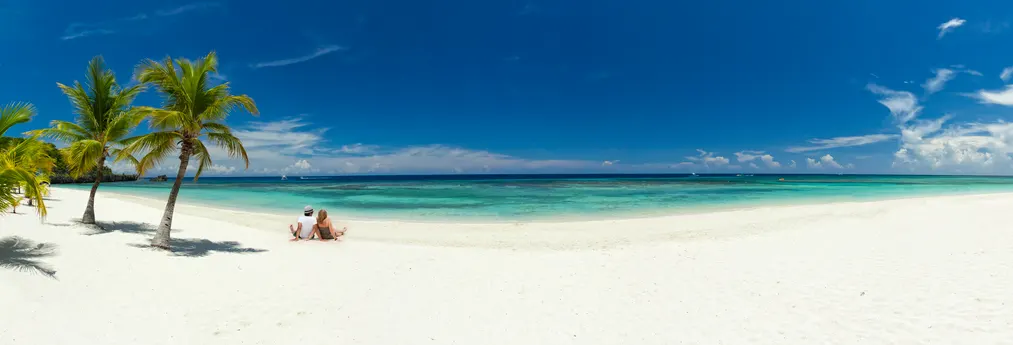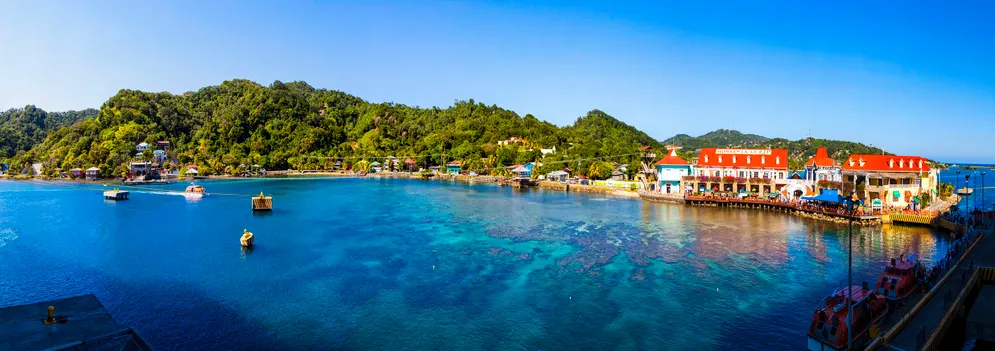Face down in bathtub-warm water, my flippered feet gently kicking, I watched rainbow-colored parrotfish meander by and blue and yellow angelfish dart past, their feathery fins flapping. A small, dark blue fish with tiny electric green dots that seemed to glow from within swam an inch from my face. I found myself lost in this glistening otherworld, just me—no family, work, past, future—the ultimate escape.
This, I thought, once I’d swapped flippers for flip flops back on dry land, is why we vacation in the first place—to really get away. Walking on the soft white sand of West Bay Beach from the Kimpton Grand Roatán, where I’d spent two hours snorkeling, toward my Airbnb in West End, I reflected on how unusual it is to see so much right offshore when you snorkel—on many islands, you’ve got to take a boat out to the reef. But this intimacy with the underwater world is just one way Roatán distinguishes itself from its Caribbean neighbors.
If you’re looking for a proper getaway, a trip to a place where you can decompress and enjoy an island that still holds on to its authentic sense of place, then sunny, postcard-perfect Roatán should be high on your list. Here are my recommendations to help you enjoy your time to the fullest.
Strategize Your Timing to Avoid the Tourist Crush

Roatán is a small Caribbean island, 45 miles from mainland Honduras and famous for its fetching beaches and world class scuba diving. Since the early ‘90s, Americans, Canadians and a smattering of Europeans have traveled—and immigrated—to Roatán because of its natural beauty, mild weather, and low cost of living.
I came here to help friends celebrate their 25th wedding anniversary, and to snorkel. Roatán’s northern and eastern shores are part of the Mesoamerican Reef, the largest barrier reef in the Western Hemisphere. With colorful names such as Happily Ever After and Mandy’s Eel Garden, hundreds of dive sites line the northern coast of the island.
I found myself lost in a glistening other world.
There are many other must-see places—remote beaches and mangroves, in particular—but my time on Roatán focused on the three-mile stretch from West Bay to West End. Until you get used to them, these town names can be confusing; West Bay is at the far western end of the island, and West End is farther north, up the coast. The latter is most popular among tourists, because it’s near the reef and home to many beaches, while also close to restaurants, shops, and a spectrum of lodging.
A local told me West Bay gets crazy during the middle of the week, when the cruise ships dock at Coxen Hole on the other side of the island, disgorging hordes of tourists.
Armed with this knowledge, I returned toward the end of the week—when I experienced that transporting two-hour snorkel.
Navigating West Bay and West End
As an inlander accustomed to only deer and squirrels, the wildlife on Roatán left me in a constant state of wonder. The morning after I arrived on the island, I was woken by birds squawking outside my cottage up the hill from Xbalanque Resort, which is halfway between West Bay and West End. Something about the sound made me think they weren’t ordinary. I stepped outside: Two bright red macaws were arguing high in a tree above my casita.
A few days later, I had a different kind of experience with the wildlife. As I walked from my Airbnb in West End to Xbalanque, I saw a bright, colorful toy or child’s flip flop rolling in the surf. I decided to get the object out of the water, so I walked into the waves and kicked it onto the beach. Cool, I thought, doing my part to decrease the Texas-sized island of plastic floating around in the ocean.
The next thought I had was more of a feeling: Why does my foot sting, and why is it red?
My friends, one of whom is a veterinarian, determined I was having an allergic reaction. It didn’t take much Googling to figure out that I’d kicked a Portuguese man o’ war with my bare foot.
Which reminds me. You can walk between West Bay and West End, but I wouldn’t recommend it. Toward West End, the trail fizzles out on rocks, and you have to billygoat it or walk in the surf. This isn’t safe during high tide, or if the wind is blowing in from the Caribbean. The way to West Bay is easier, but you have to cross a sketchy catwalk bridge over a canal.
Fortunately, for less than $10, you can hail one of the water taxis that run back and forth all day between West Bay and West End. Or, if you’re prone to seasickness, you can catch a cab instead, but these are more expensive—sometimes as high as $50—and, honestly, every bit as capable of destabilizing the stomach.
Incidentally, shuttles are the best way to get around the island, including from the airport in to the popular West Bay/West End area. (You can also rent a car, but no one I talked to recommended it.)

Don’t Miss the Chicken in West End
Luxury resorts and many nice Airbnbs lie between West Bay and West End. The facilities and staff at Xbalanque are impeccable, and Ibagari is one of the finest resorts I’ve ever seen. We dined at its restaurant, Luna Muna. Don’t let the silly name fool you; the food there was outstanding. I won’t forget the lobster risotto.
The luxury resorts are nice, but don’t let the pampering and aesthetics deprive you of the magnificent beach at West Bay and the grit and flavor of West End.
West End is gritty—still quite touristy, but more like the real Roatán. It doesn’t have the world-class beach that West Bay boasts, but it does have a mini-reef, at Half Moon Bay, that can be accessed by simply walking into the ocean.
You might assume seafood reigns here, but it’s actually chicken that the islanders have perfected. I’ve eaten my share of chicken, but I’ve never tasted anything like the jerk at Anthony’s Chicken and More. The meat was falling off the bone. This modest restaurant smells so good that the meal begins as soon as you walk in the door… which they leave wide open during business hours. Probably their evil plan to lure you in. If you can’t find a seat at Anthony’s, don’t despair. There are several street vendors nearby serving the same jerk style. You’ll spot them by the people lined up to buy.
I’d been told to go to Sandy Buns, across from Half Moon Bay, where Texan Tim Dolan specializes in biscuits (get the jalapeño), brisket and, of course, cinnamon buns. For ten bucks, I had The Bob breakfast sandwich, a large cinnamon roll, and coffee. I’m not too proud to admit that I ate the entire roll, which made me feel like I needed to swim to Jamaica or take a late-morning nap.
Sandy Bun’s menu is rotating (don’t worry—the cinnamon rolls are almost always on the menu) and Brayden, my neighbor during my stay in the West End, said that when Sandy Buns makes brownies, all the locals rush down there and buy them out.
Meeting Roatán’s Mascot
I was walking toward Xbalanque to meet my friends celebrating their anniversary. This couple loves horses and horseracing, so I thought it was fitting when I bumped into one on their special day.
The horse was standing in the water on Luna Beach, a short walk down from West End. On a previous walk, I’d seen where this horse lived, a small stable that offers rides on the beach. Guides were preparing the horses for a ride, which was why this horse was allowed to wander. He was standing in the water on Luna Beach, a short walk down from West End.
I stopped and took a few pictures, which I decided to send to my horse-loving friends, along with a congratulatory text… after I went for a swim, as I couldn’t resist the beautiful blue water in front of me. When I returned to the beach, I sat on a chunk of driftwood and composed a congratulatory message to my friends.
Then I felt something lightly touch my back. Slowly, I turned around. The horse had returned… to nuzzle my spine.
Later, I thought of the horse as a kind of mascot or ambassador for Roatán, a symbol of the kindness and gentleness of its people.
Travel Tips For Your Visit to Roatán
Best time to visit: Roatán is equatorial, so the weather doesn’t change much with the seasons, but many people prefer spring, when turtles nest and the weather is more consistent.
Transportation and logistics: Unless you’re on a cruise ship, visitors to Roatán fly into Coxen Hole, the island’s largest town. While small, Juan Manuel Galvez International Airport (RTB) can accommodate 737s and receives direct flights from Houston, Dallas-Fort Worth, Atlanta, Miami, Denver, Minneapolis and Toronto.
The airport’s website is an excellent source of information, specifically about ground transportation and water taxis. To avoid scams or excessive rates, you’ll want to look for the white cars with yellow decals and numbers. These are official cabs and, as such, should adhere to the standard cab fares, which are posted on the site and in the airport. You can also pre-book a taxi on the airport’s website.
Stay at: Luna Beach, Xbalanque, or Ibagari Boutique Hotel for resort experiences.
Cash is king: Taxis and cabs are inexpensive. You’ll want to carry some small bills to pay for them. Many restaurants and stores accept credit cards, but generally—especially if it’s a local mom and pops store—include a service charge of a couple bucks. Several do not accept them, period. In lieu of cash, many restaurants, including Sandy Buns, use cash apps such as Venmo and Paypal.
Diving and snorkeling: A plethora of diving and snorkeling guides can be found in West End and West Bay. These shops accommodate all skill levels. Only a short walk from the luxury resorts between West End and West Bay, Clearwater Adventures Dive, and Snorkel was excellent and inexpensive.
How to be a local, fast: Order Salva Vida, Honduras’ national beer, or a Monkey Lala, which is basically a chocolate milkshake with four kinds of alcohol.
How to Move Out of the U.S.
How to Move Out of the U.S.
In all sorts of beautiful, welcoming, culturally rich, saner places around the world, you can live well from $2,000 a month (all in, housing included). Sign up for our free daily IL Postcards e-letter and we’ll immediately send you a free report on the WORLD’S # 1 RETIREMENT HAVEN— plus 9 more spots you should have on your radar. Each day, you’ll earn about the best places to move to, retire, travel, buy real estate, and enjoy a good life for less, overseas.

By submitting your email address, you will receive a free subscription to IL Postcards, Overseas Dream Home, The Untourist Daily and special offers from International Living and our affiliates. You can unsubscribe at any time, and we encourage you to read more about our Privacy Policy.
